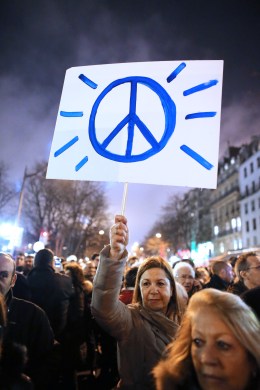
A woman holds a "peace" sign as pro-Israeli supporters take part in a demonstration called by French Jewish associations on November 20, 2012 in Paris.
There’s war in Afghanistan, a crisis in the Gaza Strip and percolating conflicts across sub-Saharan Africa. But for politicial scientists, that’s actually the good news.
The fact is, global conflicts have been on a downward trend for the last half-century. And now, a group of researchers in Norway says their data indicates that the future could be even more peaceful.
In a paper soon to be published in International Studies Quarterly, Håvard Hegre, a professor of political science at the University of Oslo, claims that the number of ongoing conflicts will be halved by 2050 — with the greatest decrease coming in the Middle East.
(MORE: Of War and Thanksgiving)
Hegre, along with his colleagues at the Peace Research Institute Oslo, put together a statistical model that took into account factors such as infant mortality, education, youth population, ethnic make-up and conflict history. They ran the conflict simulation program 18,000 times before drawing conclusions.
The group focused on internal armed conflicts between governments and organized groups; as Hegre tells TIME, “internal armed conflicts kill more people and last longer.” While the general trend shows a tendency towards peace, it’s not all good news. Owing to development factors and conflict histories, some countries will see a greater risk of conflict as time goes by. Between now and 2017, India, Ethiopia, the Philippines, Uganda and Burma will all be at greatest risk of internal conflict. By 2050 that list will narrow down to India, Nigeria, Sudan, Ethiopia and Tanzania.
(MORE: War Is An Ugly Business )
Regionally, all continents should expect to see a decline in the risk of conflict, except for sub-Saharan Africa, a region that will be home to 41% of the world’s youth population in less than three generations’ time.
Given the carnage on your average evening news broadcast, the idea that humans are resisting our violent impulses would appear to be a fantasy. However, despite the apparent prevalence of war, it is in fact in decline. In 1992 every fourth country was involved in an armed conflict; by 2009 that number had fallen to every sixth country.
(MORE: TIME Archive 1967 – The Morality of War)
The question that remains unanswered is why. Hegre explains that while it is difficult to emphasize one factor over another, education is key. “India is on the list because it is so large and it has a history of conflict in the North, but if they made an effort to expand education, they will reduce their risk of armed conflict,” says Hegre.
Another factor is economic development. Europe, despite its current economic troubles, is nevertheless still at low risk for armed conflict. This is because “developed economies tend to have invested a lot in exchange between different networks,” explains Hegre, “violence destroys those networks.” In other words, the more you have to lose, the less appealing war is.
(MORE: Obama’s Long Game on Middle East Peace)
What is missing from the study, Hegre acknowledges, is the consideration of the existing political conditions within a country. When the study was first completed in 2009, researchers predicted the Middle East to be at a low risk for war. The Arab Spring, however, changed that equation by upending many of the region’s governmental systems. “We underestimated the risk of conflict in the Middle East because we didn’t see how dependent middle income countries are on the nature of political systems,” says Hegre. He is hoping to focus on expanding on this in future studies.
MORE: Dronestagram: Using Social Media to Put Drone Strike Sites on the Map — Literally






